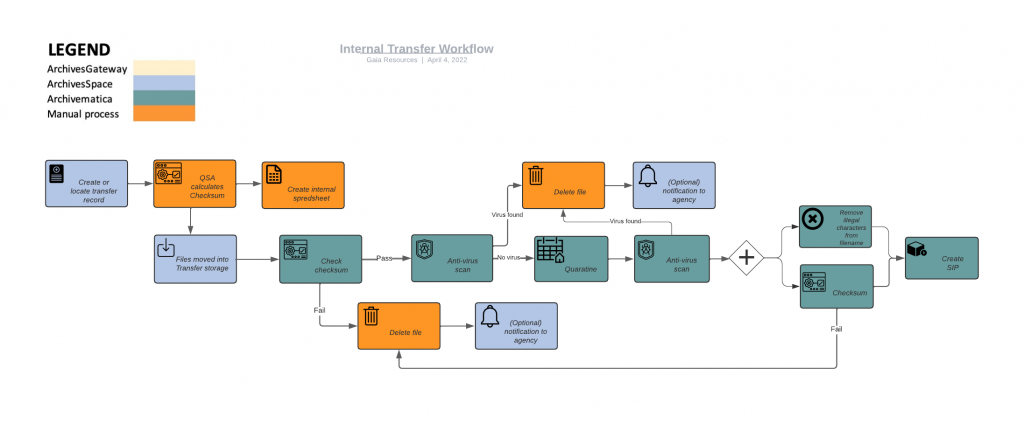Gaia Resources has been working in Digital Preservation since 2018. Most recently, in the last year and a half, we have worked closely with Queensland State Archives (QSA) to develop their Digital Preservation Storage and System. Designed to support QSA’s internal workflows, the software solution and integration assist the Archivists from the transfer proposal and material acquisition stage to ingest, storage, and collection management. In mid-January this year we wrapped up our final development sprint with QSA for their internal workflow. At the same time, the Digital Preservation Coalition (DPC) released a call for volunteers to present their pre-ingest workflows in their series ‘Workflow Webinars’. With development wrapped and the first of two QSA go-lives on the books for this year, it was the perfect time to share our and QSA’s work with the wider digital preservation community.
The ‘Workflow Webinar’ series was hosted by the DPC-led, Community Owned Workflow (COW) group. It is a forum developed out of the need for shared Digital preservation knowledge and workflows amongst practitioners. The COW resources are hosted through the Community-Owned digital Preservation Tool Registry (COPTR) wiki. It is a great online resource and is worth looking through when you have the time. https://coptr.digipres.org/index.php/Workflow:Community_Owned_Workflows
QSA and Gaia responded together to the request for presenters and we were booked into Episode 3 of the webinar series in March. The aim was to highlight the primary decisions and the tools that were implemented to enable the Archivist workflow. Of key importance was demonstrating how QSA planned to do Digital Preservation at scale – including large ingests, as well as collecting and preserving the large influx of digital material in the pipeline.
On the day, QSA and Gaia Resources split the twenty-minute time slot, with QSA leading the discussion. They laid out their plan to address legacy records transferred to them on physical media types, which are quickly becoming obsolete (think floppy disks). Gaia Resources followed with an explanation of how and why with our consortium partners, Hudson Molonglo, Record Keeping Innovations, and Artefactual, we built a pre-ingest workflow into ArchivesSpace. The integration of the Digital Preservation System into the existing Archival Management System provides the Archivists with a single point of truth, ArchivesSpace. The pre-ingest workflow in ArchivesSpace authenticates the digital material sent by state agencies, ensuring files have not encountered alteration or bitrot before being imported into the Digital Preservation System. Once the checks are complete, the user clicks the ‘Begin Import’ button, initiating the Digital Preservation workflow.
Our presentation was well received and nicely expanded on the previous talks in the session. The first session was a great talk by Julia Miller from the PARADISEC Archive. She focused on small archive workflows and talked through the tools that are used at PARADISEC. However, another excellent component of her talk was about the education tools PARADISEC provides for other small archives. Building on Julia’s talk, Andrew Martin from DAMSmart discussed the work that DAMSmart has done with PARADIESEC to digitise and preserve their collection, as well as, provide education around tools and uses. Thus, Episode 3 of the series covered ways that small archives can get started in digital preservation and moved into decisions and considerations when conducting digital preservation activities at scale.
Our team has enjoyed working in digital preservation, collaborating with clients and staying in tune with the wider field. We have participated in continual education opportunities in the digital preservation field and work to gain insight into the processes that others are implementing across the world. Some of our members of the collection team recently attended a DatacomIT webinar ‘Where to Start with Digital Preservation’ in February. It was a high-level session that gave an overview of the fundamentals of implementing digital preservation in various organisations. This session included an introduction from Robin Wright, the Head of the local DPC Australasia and Asia Pacific branch. It is always a good feeling at these events when you fact-check conversations that are had internally and with clients and you know we are headed in the right direction.
We look forward to exploring future opportunities and expanding our engagements.
Are you interested in digital preservation? Get in touch with us via email or start a conversation with us on one of our social media platforms Twitter, LinkedIn or Facebook
Sarah



Comments are closed.